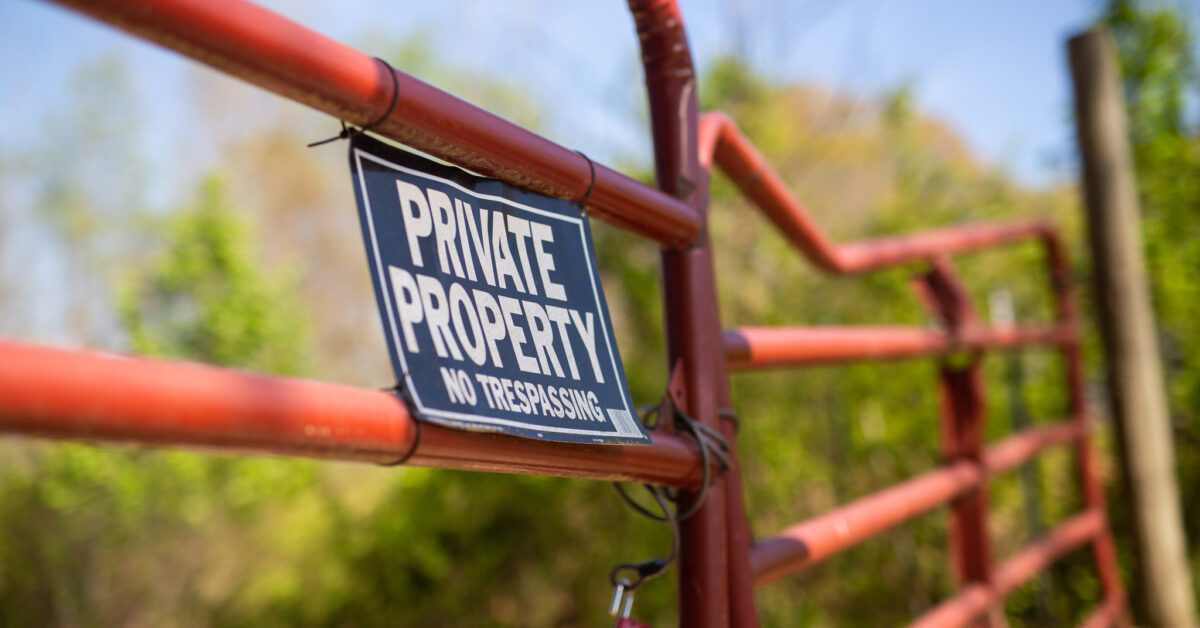Few American landowners realize that the “no trespassing” signs, fences, and gates they install are no barrier to government agents. A new study from the Institute for Justice (IJ), released this week in the Cato Institute’s magazine Regulation, for the first time quantifies just how much property is open to warrantless searches thanks to a legal precedent known as the “open fields doctrine.” IJ found that nearly 96% of all private land in the country—about 1.2 billion acres—is essentially open to government trespasses.
“This is a groundbreaking study,” said IJ Attorney Josh Windham. “The open fields doctrine has been around for a century, yet nobody has ever measured its real-world impact. Now we have hard data showing that the Supreme Court’s century-old error blew a massive hole in Americans’ property and privacy rights. Now we know what the open fields doctrine really means: Government officials can treat almost all private land in this country like public property. Now courts and lawmakers across the country will have to face the consequences of keeping this doctrine on the books.”
In a 1924 case, Hester v. U.S., the U.S. Supreme Court held that Fourth Amendment’s ban on warrantless searches did not apply to “open fields,” meaning all land not immediately near a home. One hundred years later, the open fields doctrine is relied on by government agents to enter private property for any reason and at any time. This includes activities like covert surveillance, placing cameras, and taking cameras from private property.
Using sophisticated mapping software, IJ was able to analyze the number of acres of land in each state that is privately owned and not near a home or building. The study made generous assumptions about what areas would be protected by the Fourth Amendment, treating all structures and a 100-foot buffer around those structures as protected. The results show the massive scope of the open fields doctrine.
“It’s worth noting that our methodology here was quite conservative,” said IJ Senior Research Analyst Dave Warren. “We likely over-estimated the amount of land that would receive Fourth Amendment protection under current law, both by assuming that every structure has some amount of protected land around it and by affording each structure a 100-foot buffer of protection, when in reality courts protect land only around the home and only on a case-by-case basis. Our analytical assumptions were also intended to provide a conservative lower-bound estimate of the share of protected land, so our core finding—about 96% of all private land receives zero protection—likely undershoots the real figure.”
Although the Fourth Amendment and federal legal precedents provide the minimum level of protection for Americans, state constitutions can provide greater protection for property owners. Seven states have rejected the open fields doctrine under their own constitutions. The study compared the amount of private land in those states eligible for protection under the federal constitution versus the state constitution and found a difference of more than 160 million acres.
IJ is representing property owners seeking to challenge the open fields doctrine in four states. In Tennessee, a trial court held that the state law permitting warrantless searches was unconstitutional. The Pennsylvania Supreme Court will hear argument later this year in a challenge from several hunting clubs. In Virginia, a homeowner sued last year after agents entered his property and seized a game camera without a warrant. And in Louisiana, a forester who raises timber and hunts on his property is suing over recent warrantless searches by multiple wardens.
IJ’s Center for Judicial Engagement will mark the 100th anniversary of Hester v. U.S. with a conference at its Washington, D.C.-area headquarters on May 10th, 2024. IJ attorneys and nationally recognized Fourth Amendment scholars will examine the history and future of the open fields doctrine. Members of the public and the press are invited to register online at https://ij.org/event/open-fields-conference/ .

New Study Shows How Much Private Property the Supreme Court Has Excluded From Fourth Amendment Protection - Institute for Justice
ARLINGTON, Va.—Few American landowners realize that the “no trespassing” signs, fences, and gates they install are no barrier to government agents. A new study from […]
Reminds me of the "100 miles from the border Constitution Free Zone":
